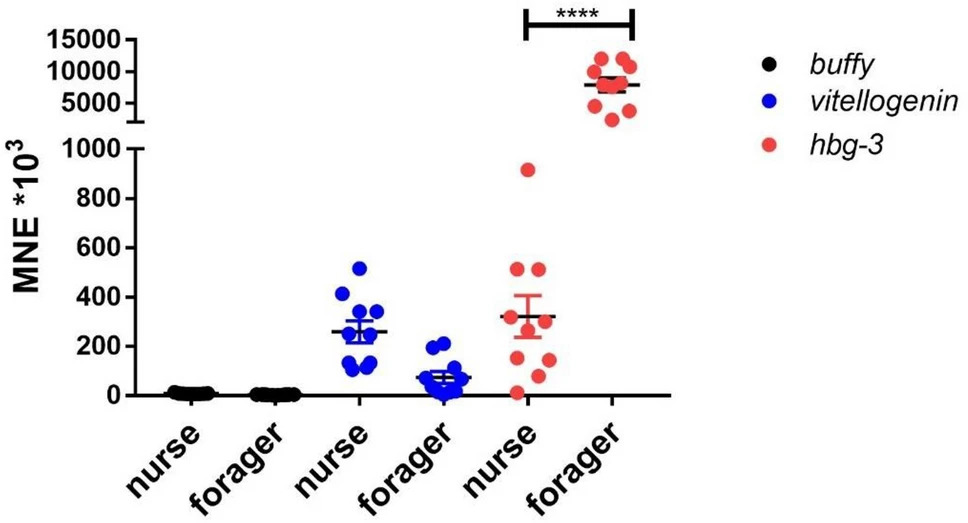Different effects of pesticides on transcripts of the endocrine regulation and energy metabolism in honeybee foragers from different colonies
Scientific Reports volume 13, Article number: 1985 (2023)
Abstract

Abundance of transcripts of buffy (black symbols), vitellogenin (blue symbols) and hbg-3 (red symbols) in the brain of unexposed nurse bees (n = 10) and foragers (n = 10) from the same hive. Significant differences between nurse bees and foragers with p-value of ≤ 0.05 are marked with *.
Honey bees are important pollinators of many crops and contribute to biological biodiversity. For years, a decline in bee populations has been observed in certain areas. This decline in honeybees is accompanied by a decrease in pollinator services. One factor contributing to the decline of bee colonies is the exposure to pesticides. Pesticide exposure of bees, among other effects, can negatively affect orientation, memory, immune system function and gene expression. Among the altered expressed genes are transcripts of endocrine regulation and oxidative phosphorylation. Endocrine regulation plays an important role in the development of nurse bees into foragers and oxidative phosphorylation is involved in energy metabolism. Most of these transcriptional changes were investigated using mixed aged honeybees derived from the same colony. Experiments using nurse bees or foragers of the same age but from different colonies are rare. In the present study, effects of the two pesticides chlorpyrifos and pyraclostrobin on the expression of transcripts linked to endocrine regulation and oxidative phosphorylation in foragers of the same age from three different colonies are investigated to fill this gap. These two pesticides were selected because negative effects at sublethal concentrations on bees are known and because they are found in pollen and nectar of crops and wild plants. For this purpose, 20–22 days old foragers of three different colonies were exposed to different sublethal concentrations of the selected fungicides for 24 h, followed by analysis of the expression of buffy, vitellogenin, hbg-3, ilp-1, mrjp1, 2 and 3, cox5a, cox5b and cox17. Some significant changes in gene expression of both endocrine regulation transcripts and oxidative phosphorylation were shown. Furthermore, it became clear that forager bees from different colonies react differently. This is especially important in relation to the risk analysis of pesticides. In addition, it could be shown that the expression of hbg-3 in the brain of bees is a robust marker to distinguish nurse bees from foragers at the molecular biological level. In summary, this study clearly shows that pesticides, which are often detected in pollen and nectar, display negative effects at sublethal concentrations on bees and that it is important to use bees from different colonies for risk assessment of pesticides.
We are here to share current happenings in the bee industry. Bee Culture gathers and shares articles published by outside sources. For more information about this specific article, please visit the original publish source: Different effects of pesticides on transcripts of the endocrine regulation and energy metabolism in honeybee foragers from different colonies | Scientific Reports (nature.com)






